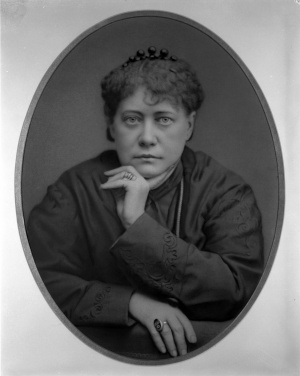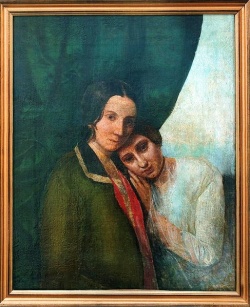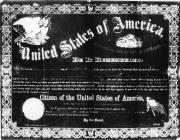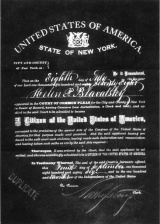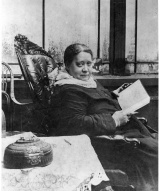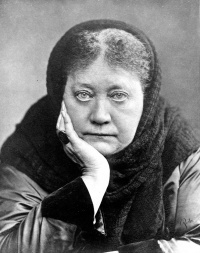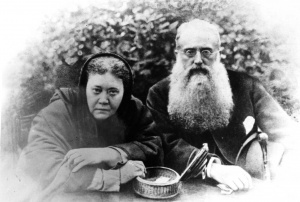Helena Petrovna Blavatsky: Difference between revisions
Pablo Sender (talk | contribs) No edit summary |
|||
| Line 16: | Line 16: | ||
After her mother’s death, Helena’s grandfather Andrei Mikhailovich and Grandmother Helena Pavlovna had taken the children to Saratov, where they had quite a different life. Fadeyev’s house was visited by Saratov’s intellectuals. | After her mother’s death, Helena’s grandfather Andrei Mikhailovich and Grandmother Helena Pavlovna had taken the children to Saratov, where they had quite a different life. Fadeyev’s house was visited by Saratov’s intellectuals. | ||
== | === First marriage === | ||
Striving for full independence in 1849, at Tiflis, 16-year old Helena married vice-governor of Erevan Nikifor Vladimirovich Blavatsky, who was much older. On [[June 7]], 1849 their wedding ceremony took place. Soon after their wedding, Helena escaped from the husband and returned to her relatives.<ref>исьмо А. М. Дондукову-Корсакову от 1 марта 1882 года // Блаватская Е. П. «Письма друзьям и сотрудникам». Сборник. Перев. с англ. — М., 2002. — С. 250 ISBN 5-93975-062-1</ref> Nikifor Blavatsky tried to obtain a divorce on the ground that "his marriage had never been more than a form." His attempt failed, however, owing to the fact Russian law at the time regarded divorce with disfavor. It is not certain when Nikifor died. In Helena's scrapbook there is a cutting from a newspaper talking about her life, where we find the sentence: "For many years they [Helena and Nikifor] resided together at Odessa, and finally a legal separation was affected." To this, HPB added two notes. The one commenting on her stay with her husband "for many years" said: "a lie—was with him but for three weeks." To the second phrase: "finally a legal separation was affected" she added "legal, because he died." The name and date of the newspaper do not appear in print, but H.P.B. wrote in ink above the cutting: "From the N. Y. Mercury, Jan. 18, 1875."<ref>Blavatsky, H. P., ''Collected Writings'' vol. I (Wheaton, Ill: Theosophical Publishing House, ???), 54.</ref> | Striving for full independence in 1849, at Tiflis, 16-year old Helena married vice-governor of Erevan Nikifor Vladimirovich Blavatsky, who was much older. On [[June 7]], 1849 their wedding ceremony took place. Soon after their wedding, Helena escaped from the husband and returned to her relatives.<ref>исьмо А. М. Дондукову-Корсакову от 1 марта 1882 года // Блаватская Е. П. «Письма друзьям и сотрудникам». Сборник. Перев. с англ. — М., 2002. — С. 250 ISBN 5-93975-062-1</ref> Nikifor Blavatsky tried to obtain a divorce on the ground that "his marriage had never been more than a form." His attempt failed, however, owing to the fact Russian law at the time regarded divorce with disfavor. It is not certain when Nikifor died. In Helena's scrapbook there is a cutting from a newspaper talking about her life, where we find the sentence: "For many years they [Helena and Nikifor] resided together at Odessa, and finally a legal separation was affected." To this, HPB added two notes. The one commenting on her stay with her husband "for many years" said: "a lie—was with him but for three weeks." To the second phrase: "finally a legal separation was affected" she added "legal, because he died." The name and date of the newspaper do not appear in print, but H.P.B. wrote in ink above the cutting: "From the N. Y. Mercury, Jan. 18, 1875."<ref>Blavatsky, H. P., ''Collected Writings'' vol. I (Wheaton, Ill: Theosophical Publishing House, ???), 54.</ref> | ||
=== Travels === | |||
== | |||
== | |||
Shortly after her marriage Helena began more than 20 years of extensive travel, bringing her into contact with mystic traditions the world over. This period of Blavatsy’s life is difficult for her biographers as she did not keep diaries and there was nobody with her to tell about these events. The picture of the route and course of the travels is based mainly on Blavatsky’s own memories, which sometimes contain the chronological contradictions. N. A. Fadeyeva reported that only her father knew where his daughter was, and from time to time would send money to her. | Shortly after her marriage Helena began more than 20 years of extensive travel, bringing her into contact with mystic traditions the world over. This period of Blavatsy’s life is difficult for her biographers as she did not keep diaries and there was nobody with her to tell about these events. The picture of the route and course of the travels is based mainly on Blavatsky’s own memories, which sometimes contain the chronological contradictions. N. A. Fadeyeva reported that only her father knew where his daughter was, and from time to time would send money to her. | ||
| Line 87: | Line 61: | ||
1873: Lived in Paris and sailed to the USA. | 1873: Lived in Paris and sailed to the USA. | ||
== | == Life in the United States == | ||
In 1873, in Paris, she received an order from her [[Master]] to go to the United States and meet with Col. [[Henry Steel Olcott|Henry S. Olcott]], who was now about to become a journalist, reporting on spiritualistic phenomena. It was in this capacity that, a year later, he met Mme. Blavatsky, and they quickly became friends. | In 1873, in Paris, she received an order from her [[Master]] to go to the United States and meet with Col. [[Henry Steel Olcott|Henry S. Olcott]], who was now about to become a journalist, reporting on spiritualistic phenomena. It was in this capacity that, a year later, he met Mme. Blavatsky, and they quickly became friends. | ||
As she began to instruct Col. Olcott in the occult science and esoteric philosophy, the two started working together in connection with the Spiritualistic movement in the US. During this time, HPB performed at will many phenomena normally ascribed to “the spirits,” and published articles in different spiritualistic journals explaining the origin and nature of these psychic incidents, in ways that contradicted many of the Spiritualists' theories. Most spiritualists were not pleased with HPB’s attempt to reform, sometimes quite radically, their believes. | As she began to instruct Col. Olcott in the occult science and esoteric philosophy, the two started working together in connection with the Spiritualistic movement in the US. During this time, HPB performed at will many phenomena normally ascribed to “the spirits,” and published articles in different spiritualistic journals explaining the origin and nature of these psychic incidents, in ways that contradicted many of the Spiritualists' theories. Most spiritualists were not pleased with HPB’s attempt to reform, sometimes quite radically, their believes. | ||
=== American citizenship === | |||
[[File:HPB citizenship 1.jpg|180px|left|thumb|Certificate of citizenship]] | |||
[[File:HPB citizenship.jpg|160px|right|thumb|New York Court of Common Pleas grant of citizenship]] | |||
On [[September 22]], 1874, Mme. Blavatsky signs a U.S.A. Government application form expressing her intention to become naturalized. | |||
On [[July 8]], 1878, "Helen P. Blavatsky" appeared in the Court of Common Pleas in New York City and completed the process of applying for citizenship in the United States. | |||
<br> | |||
<br> | |||
<br> | |||
<br> | |||
<br> | |||
<br> | |||
<br> | |||
<br> | |||
<br> | |||
<br> | |||
=== Second marriage === | |||
On [[April 3]], 1875, in New York, a few months before founding the [[Theosophical Society]], Mme. Blavatsky married with a Georgian living in America [[Michael C. Betanelly]]. The marriage broke after several months and Betanelly sued for a divorce. The divorce was granted on [[May 25]], 1878, with [[William Quan Judge|William Q. Judge]] acting as Blavatsky's counsel. | |||
=== Founding of the Theosophical Society === | |||
[[File:HPB reading book JPEG.jpg|160px|left|thumb|HPB reading]] | |||
In July 1875, HPB wrote in her scrapbook: "Orders received from India direct to establish a philosophico-religious society and choose a name for it, also to choose Olcott."<ref>Caldwell, Daniel H. ''The Esoteric World of Madame Blavatsky'' (Wheaton, Ill., Quest Books, 2001), 71</ref> In the Fall of the same year, along with [[Henry Steel Olcott|H. S. Olcott]], [[William Quan Judge|W. Q. Judge]], and others, the [[Theosophical Society]] was founded. | In July 1875, HPB wrote in her scrapbook: "Orders received from India direct to establish a philosophico-religious society and choose a name for it, also to choose Olcott."<ref>Caldwell, Daniel H. ''The Esoteric World of Madame Blavatsky'' (Wheaton, Ill., Quest Books, 2001), 71</ref> In the Fall of the same year, along with [[Henry Steel Olcott|H. S. Olcott]], [[William Quan Judge|W. Q. Judge]], and others, the [[Theosophical Society]] was founded. | ||
== Writing of ''Isis Unveiled'' == | === Writing of ''Isis Unveiled'' === | ||
[[File:HP Blavatsky 1.jpg|200px|right]] | [[File:HP Blavatsky 1.jpg|200px|right]] | ||
H. P. Blavatsky's first major literary effort was ''Isis Unveiled'', a critical response to the growing materialism in both scientific and religious institutions, is a vindication of the ageless quest. The book was started in 1875, a few months before the formation of the [[Theosophical Society]], although at the time HPB did not know what was to become of the growing pile of manuscripts. | H. P. Blavatsky's first major literary effort was ''Isis Unveiled'', a critical response to the growing materialism in both scientific and religious institutions, is a vindication of the ageless quest. The book was started in 1875, a few months before the formation of the [[Theosophical Society]], although at the time HPB did not know what was to become of the growing pile of manuscripts. | ||
| Line 102: | Line 100: | ||
Described as "A Master-Key to the Mysteries of Ancient and Modern Science and Theology," the book was published in two volumes in 1877, quickly becoming a classic in occult literature. Two large editions of this "epoch-making" work were sold immediately, and new editions have been appearing ever since. | Described as "A Master-Key to the Mysteries of Ancient and Modern Science and Theology," the book was published in two volumes in 1877, quickly becoming a classic in occult literature. Two large editions of this "epoch-making" work were sold immediately, and new editions have been appearing ever since. | ||
== | == Life in India == | ||
[[File:Blavatsky Olcott.jpg|300px|right]] | [[File:Blavatsky Olcott.jpg|300px|right]] | ||
=== At Bombay === | |||
=== At Adyar === | |||
== Health == | |||
=== Injured leg === | |||
In the last days of January, 1875, Mme. Blavatsky injures her leg and hurts her knee. By the middle of April [[John King]] cures the leg, but the trouble returns owing to lack of rest. By May her leg gets worse, it is becoming paralyzed and may require amputation. A message precipitated from John King says he will cure it. On June 3rd, at midnight, H.P.B. lay cold, pulse-less, and rigid; her injured leg had swollen to twice the natural size and had turned black. Her physician had given her up and her attendants thought her to be dead. However, within a few hours, the swelling subsided and she revived. | |||
During that month H.P.B. is still very ill and according to her husband, [[Michael C. Betanelly]] she sometimes appears to be "dead". This causes a great puzzle to doctors. As it would appear from Master [[Serapis]]' letters to [[Henry Steel Olcott|Col. Olcott]], she is undergoing some grave trial, most likely an [[initiation]]. By the end of the month H.P.B. is much better and planning future trips. | |||
== Production of phenomena == | == Production of phenomena == | ||
| Line 114: | Line 123: | ||
== The Hodgson Report == | == The Hodgson Report == | ||
== | == Life in Europe == | ||
=== Writing of the ''Secret Doctrine'' === | |||
== | === Blavatsky Lodge === | ||
=== Esoteric Section === | |||
== Death == | == Death == | ||
Revision as of 16:36, 25 September 2013

Helena Petrovna Blavatsky (Russian: Еле́на Петро́вна Блава́тская, Ukrainian: Олена Петрівна Блаватська), was born at Dnepropetrovsk (Ekaterinoslav), Ukraine, on August 12, 1831. She was a Theosophist, writer, and traveler. Between 1848 and 1875 Blavatsky went around the world three times. In 1875 Blavatsky, together with Colonel H. S. Olcott, established the Theosophical Society. Blavatsky was the main source of Theosophical teachings and discussed the major themes of Theosophy in many articles and several major works, including Isis Unveiled, The Secret Doctrine, The Key to Theosophy, and The Voice of the Silence. She died in London, on May 8, 1891.
Early years
Born as Helena von Hahn (Russian: Елена Петровна Ган, Ukrainian: Олена Петрівна Ган) she was the daughter of Colonel Peter Alexeyevich von Hahn and novelist Helena Andreyevna (née de Fadeyev).
On July 6, 1842 Helena Andreevna Hahn, Helena’s mother and at that time a well-known writer, died at the age of 28 of galloping consumption.
According to Vera Jelihovsky, Helena's mother, at the time, was worried about the destiny of her elder daughter, “gifted from childhood by outstanding features”.[1] Before her death, her mother said: “Well! Perhaps it is for the better that I am dying: at least, I will not suffer from seeing Helena’s hard lot! I am quite sure that her destiny will be not womanly, that she will suffer much”.[2]
After her mother’s death, Helena’s grandfather Andrei Mikhailovich and Grandmother Helena Pavlovna had taken the children to Saratov, where they had quite a different life. Fadeyev’s house was visited by Saratov’s intellectuals.
First marriage
Striving for full independence in 1849, at Tiflis, 16-year old Helena married vice-governor of Erevan Nikifor Vladimirovich Blavatsky, who was much older. On June 7, 1849 their wedding ceremony took place. Soon after their wedding, Helena escaped from the husband and returned to her relatives.[3] Nikifor Blavatsky tried to obtain a divorce on the ground that "his marriage had never been more than a form." His attempt failed, however, owing to the fact Russian law at the time regarded divorce with disfavor. It is not certain when Nikifor died. In Helena's scrapbook there is a cutting from a newspaper talking about her life, where we find the sentence: "For many years they [Helena and Nikifor] resided together at Odessa, and finally a legal separation was affected." To this, HPB added two notes. The one commenting on her stay with her husband "for many years" said: "a lie—was with him but for three weeks." To the second phrase: "finally a legal separation was affected" she added "legal, because he died." The name and date of the newspaper do not appear in print, but H.P.B. wrote in ink above the cutting: "From the N. Y. Mercury, Jan. 18, 1875."[4]
Travels
Shortly after her marriage Helena began more than 20 years of extensive travel, bringing her into contact with mystic traditions the world over. This period of Blavatsy’s life is difficult for her biographers as she did not keep diaries and there was nobody with her to tell about these events. The picture of the route and course of the travels is based mainly on Blavatsky’s own memories, which sometimes contain the chronological contradictions. N. A. Fadeyeva reported that only her father knew where his daughter was, and from time to time would send money to her.
1849/50: Left her husband and travelled in Turkey, Greece, Egypt and France
1851: Met the man who was to her guru in London (always referred to as 'Master')
1851: Sailed for Canada, travelled south to New Orleans, Mexico and South America
1852: From the West Indies sailed via the Cape and Ceylon to India
1852: Attempted unsuccessfully to enter Tibet
1853: Travelled via Java to England
1854: Returned to America, crossing The Rockies with a caravan of emigrants
1855: Returned to India via Japan and The Straights
1856/57: Travelled throughout India, Kashmir, Ladakh, Burma, and parts of Tibet
1858: Returned to Russia via Java, France and Germany
1860/65: Lived with the native tribes in the Caucasus
1866/67: Travelled in the Balkans, Egypt, Syria and Italy
1867: Wounded at the Battle of Mentana in Italy
1868: Returned to India and Tibet
1871: Shipwrecked off the island of Spetsai sailing from Greece to Egypt
1871/72: Lived in Cairo
1872: Travelled through Syria, Palestine, the Lebanon, and back to Odessa
1873: Lived in Paris and sailed to the USA.
Life in the United States
In 1873, in Paris, she received an order from her Master to go to the United States and meet with Col. Henry S. Olcott, who was now about to become a journalist, reporting on spiritualistic phenomena. It was in this capacity that, a year later, he met Mme. Blavatsky, and they quickly became friends.
As she began to instruct Col. Olcott in the occult science and esoteric philosophy, the two started working together in connection with the Spiritualistic movement in the US. During this time, HPB performed at will many phenomena normally ascribed to “the spirits,” and published articles in different spiritualistic journals explaining the origin and nature of these psychic incidents, in ways that contradicted many of the Spiritualists' theories. Most spiritualists were not pleased with HPB’s attempt to reform, sometimes quite radically, their believes.
American citizenship
On September 22, 1874, Mme. Blavatsky signs a U.S.A. Government application form expressing her intention to become naturalized.
On July 8, 1878, "Helen P. Blavatsky" appeared in the Court of Common Pleas in New York City and completed the process of applying for citizenship in the United States.
Second marriage
On April 3, 1875, in New York, a few months before founding the Theosophical Society, Mme. Blavatsky married with a Georgian living in America Michael C. Betanelly. The marriage broke after several months and Betanelly sued for a divorce. The divorce was granted on May 25, 1878, with William Q. Judge acting as Blavatsky's counsel.
Founding of the Theosophical Society
In July 1875, HPB wrote in her scrapbook: "Orders received from India direct to establish a philosophico-religious society and choose a name for it, also to choose Olcott."[5] In the Fall of the same year, along with H. S. Olcott, W. Q. Judge, and others, the Theosophical Society was founded.
Writing of Isis Unveiled
H. P. Blavatsky's first major literary effort was Isis Unveiled, a critical response to the growing materialism in both scientific and religious institutions, is a vindication of the ageless quest. The book was started in 1875, a few months before the formation of the Theosophical Society, although at the time HPB did not know what was to become of the growing pile of manuscripts.
Described as "A Master-Key to the Mysteries of Ancient and Modern Science and Theology," the book was published in two volumes in 1877, quickly becoming a classic in occult literature. Two large editions of this "epoch-making" work were sold immediately, and new editions have been appearing ever since.
Life in India
At Bombay
At Adyar
Health
Injured leg
In the last days of January, 1875, Mme. Blavatsky injures her leg and hurts her knee. By the middle of April John King cures the leg, but the trouble returns owing to lack of rest. By May her leg gets worse, it is becoming paralyzed and may require amputation. A message precipitated from John King says he will cure it. On June 3rd, at midnight, H.P.B. lay cold, pulse-less, and rigid; her injured leg had swollen to twice the natural size and had turned black. Her physician had given her up and her attendants thought her to be dead. However, within a few hours, the swelling subsided and she revived.
During that month H.P.B. is still very ill and according to her husband, Michael C. Betanelly she sometimes appears to be "dead". This causes a great puzzle to doctors. As it would appear from Master Serapis' letters to Col. Olcott, she is undergoing some grave trial, most likely an initiation. By the end of the month H.P.B. is much better and planning future trips.
Production of phenomena
Mme. Blavatsky produced a number of phenomena and never taking the credit for them, but using them to prove the powers of the Masters of Wisdom. This eventually generated problems, as Mahatma K. H. described to Mr. Sinnett in one of his letters:
Know then, that if she ever became guilty of real, deliberate deception, owing to that "zeal," it was when in the presence of phenomena produced, she kept constantly denying — except in the matter of such trifles as bells and raps — that she had anything to do with their production personally. From your "European standpoint" it is downright deception, a big thundering lie; from our Asiatic standpoint, though an imprudent, blamable zeal, an untruthful exaggeration, or what a Yankee would call "a blazing cock-a-hoop" meant for the benefit of the "Brothers", — Yet withal, if we look into the motive — a sublime, self-denying, noble and meritorious — not dishonest — zeal. Yes; in that, and in that alone, she became constantly guilty of deceiving her friends. She could never be made to realize the utter uselessness, the danger of such a zeal; and how mistaken she was in her notions that she was adding to our glory, whereas, by attributing to us very often phenomena of the most childish nature, she but lowered us in the public estimation and sanctioned the claim of her enemies that she was "but a medium"! But it was of no use. In accordance with our rules, M. was not permitted to forbid her such a course, in so many words. She had to be allowed full and entire freedom of action, the liberty of creating causes that became in due course of time her scourge, her public pillory. He could at best forbid her producing phenomena, and to this last extremity he resorted as often as he could, to her friends and theosophists great dissatisfaction. [. . .] The stereotyped phrase: "It is not I; I can do nothing by myself. . . it is all they — the Brothers. . . . I am but their humble and devoted slave and instrument" is a downright fib. She can and did produce phenomena, owing to her natural powers combined with several long years of regular training and her phenomena are sometimes better, more wonderful and far more perfect than those of some high, initiated chelas, whom she surpasses in artistic taste and purely Western appreciation of art. . . . Thus, while fathering upon us all manner of foolish, often clumsy and suspected phenomena, she has most undeniably been helping us in many instances; saving us sometimes as much as two-thirds of the power used, and when remonstrated — for often we are unable to prevent her doing it on her end of the line — answering that she had no need of it, and that her only joy was to be of some use to us. And thus she kept on killing herself inch by inch, ready to give — for our benefit and glory, as she thought — her life-blood drop by drop, and yet invariably denying before witnesses that she had anything to do with it. Would you call this sublime, albeit foolish self-abnegation — "dishonest"? We do not; nor shall we ever consent to regard it in such a light.[6]
The Hodgson Report
Life in Europe
Writing of the Secret Doctrine
Blavatsky Lodge
Esoteric Section
Death
In April, 1891, a very serious epidemic of influenza reaches London. Practically the entire staff at 19 Avenue Rd. was laid up with it, three of them being at death's door. On April 25th, H.P.B. has a very high fever, and her doctor, Z. Mennell is seriously alarmed. On the 30th, a troublesome quinsy formed in her throat, but improved; then an abscess formed on the bronchial tubes, but disappeared later; her weakness, however, increased. On May 6 she somewhat improved and managed to walk into her sitting-room, though she said she felt she was dying. After another very alarming night, she sat in her arm-chair in the sitting-room, finding no ease in bed. On May 8, at 11 a.m., H.P.B. grew worse. She was in her chair, and those present were Miss Laura Cooper, Claude Falls Wright, Walter Gorn Old, and Miss Black, the nurse. She passed away rather suddenly at 2:25 p.m., Greenwich Time. Her body was cremated at Woking Crematorium, Surrey, on May 11, 1891.
Between May 8 and 9 Col. Olcott has three distinct warnings about Mme. Blavatsky's passing. He receives a cablegram about the fact on May 10.
On July 9, 1891, begins the First Annual Convention of the European Branches, held in London. Col. Olcott, who is in the Chair, suggests the partition of H.P.B.'s ashes. W. Q. Judge offers a resolution for the creation of an "H.P.B. Memorial Fund".
Online resources
For online resources of Helena Petrovna Blavatsky's writings see Blavatsky writings.
Articles and pamphlets
- H. P. Blavatsky in Theosopedia.
- Blavatsky and Mount Rushmore by John Algeo
- H. P. Blavatsky - the Light-Bringer by Geoffrey A. Barborka
- The Theosophical Society and H.P.B. by Annie Besant and H.T. Patterson
- The Truth About Madame Blavatsky by Walter A. Carrithers, Jr.
- The Esoteric She by William Q. Judge
- H.P.B. - A Lion-Hearted Colleague Passes by William Q. Judge
- H.P.B. at Enghien by William Q. Judge
- H.P.B. Was Not Deserted by the Masters by William Q. Judge
- "Yours Till Death and After, H.P.B." by William Q. Judge
- Address Read at the Cremation of HPB's Body by G. R. S. Mead
- Concerning H.P.B. - Stray Thoughts on Theosophy by G.R.S. Mead
- A Message Ahead of Its Time by Hugh Shearman
- Against Blavatsky: Rene Guenon's Critique of Theosophy by Richard Smoley
Books
- Reminiscences of H.P. Blavatsky and The Secret Doctrine by Countess Constance Wachtmeister
Audio
- The Real Madame Blavatsky by John Algeo
- Olcott and Blavatsky: Theosophical Twins by John Algeo
- H. P. Blavatsky Remembered: White Lotus Day Commemoration by David Bruce
- The Life of HPB Boris de Zirkoff
- H. P. Blavatsky: Woman of Mystery by Stephan Hoeller
Video
Additional resources
- H. P. Blavatsky - Theosophical Topics in Depth Links to articles, letters, and books on and by HPB
- Refutation of charges against Madame Blavatsky at Blavatsky Net
- H. P. Blavatsky's Natal Chart at Astrodienst
Notes
- ↑ Желиховская. Е. П. Блаватская. II. С.246.
- ↑ Jelihovsky. Helena Petrovna Blavatsky // Lucifer. C.204; The Theosophist. C. 240
- ↑ исьмо А. М. Дондукову-Корсакову от 1 марта 1882 года // Блаватская Е. П. «Письма друзьям и сотрудникам». Сборник. Перев. с англ. — М., 2002. — С. 250 ISBN 5-93975-062-1
- ↑ Blavatsky, H. P., Collected Writings vol. I (Wheaton, Ill: Theosophical Publishing House, ???), 54.
- ↑ Caldwell, Daniel H. The Esoteric World of Madame Blavatsky (Wheaton, Ill., Quest Books, 2001), 71
- ↑ Vicente Hao Chin, Jr., The Mahatma Letters to A.P. Sinnett in chronological sequence No. 92 (Quezon City: Theosophical Publishing House, 1993), 295-296.
